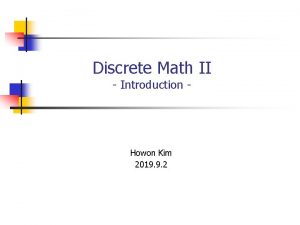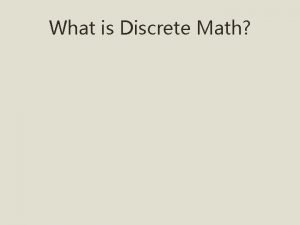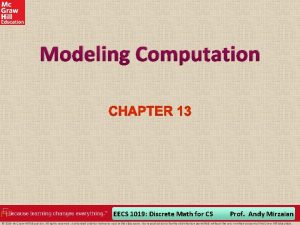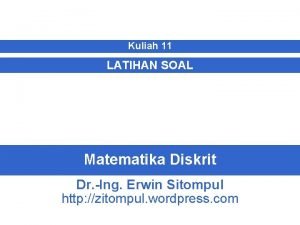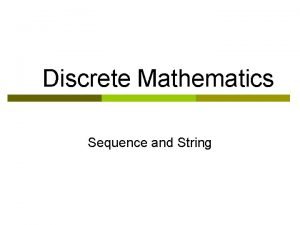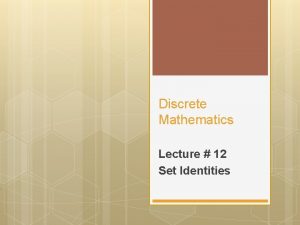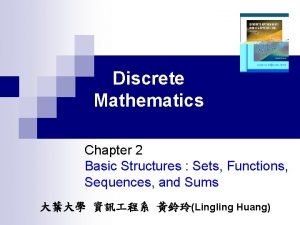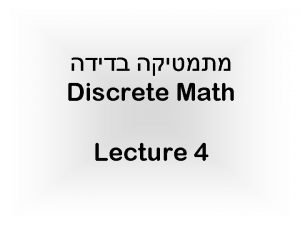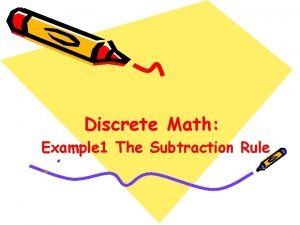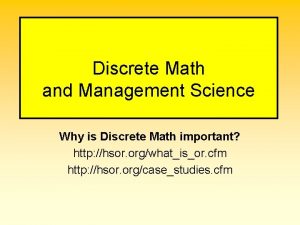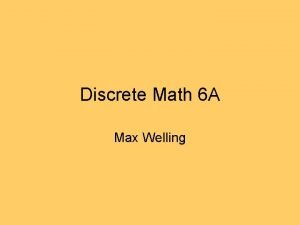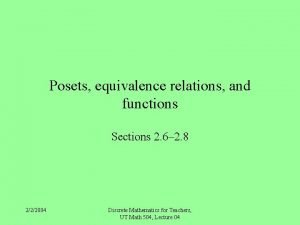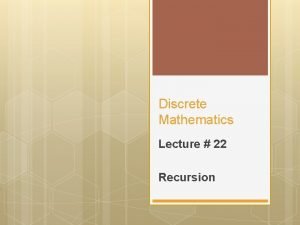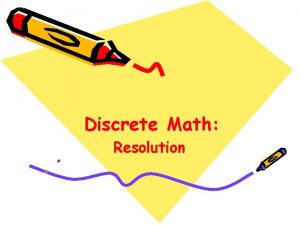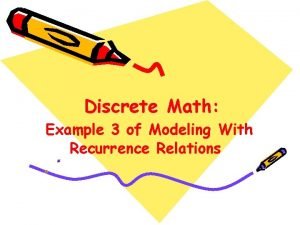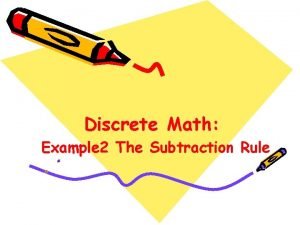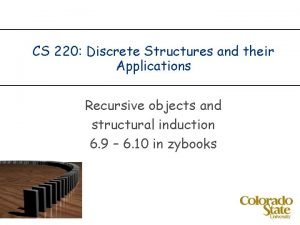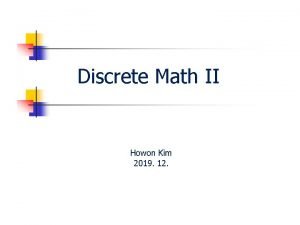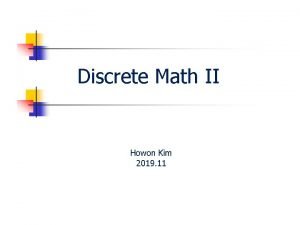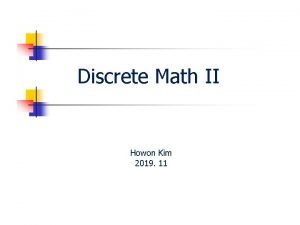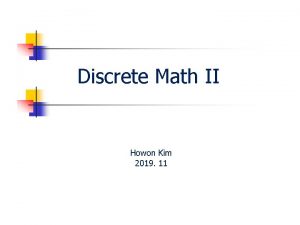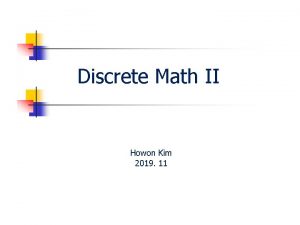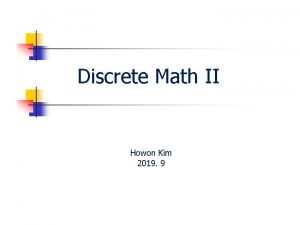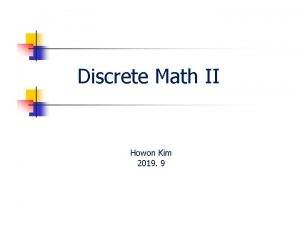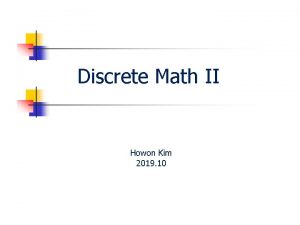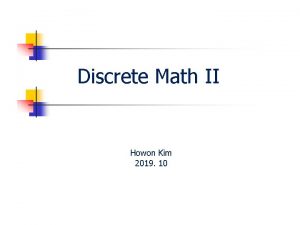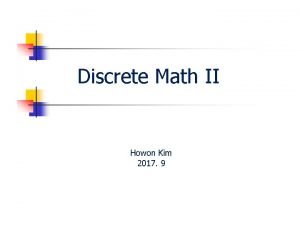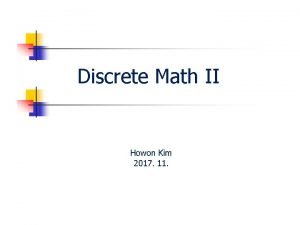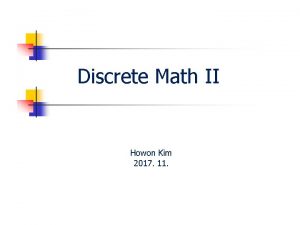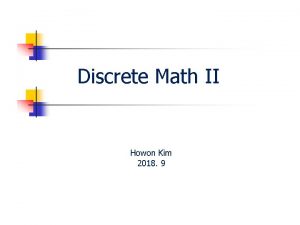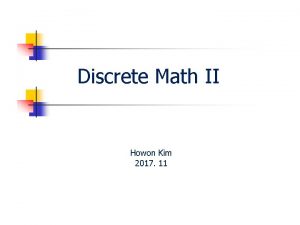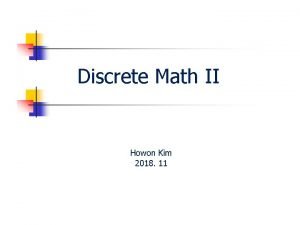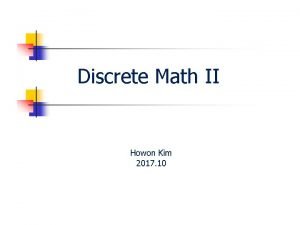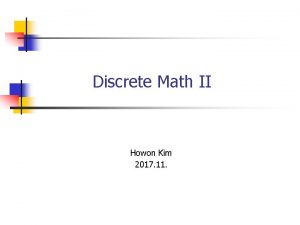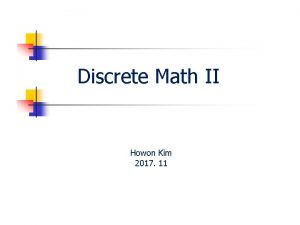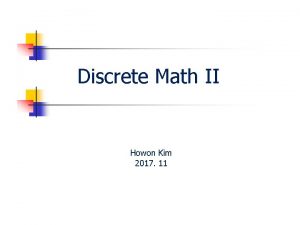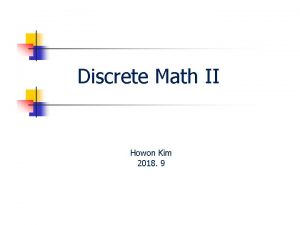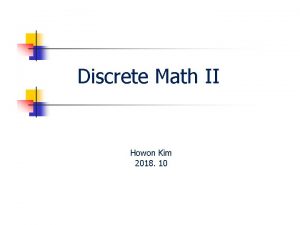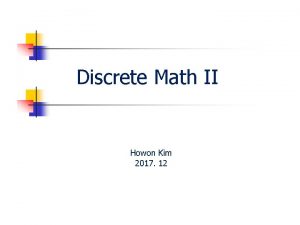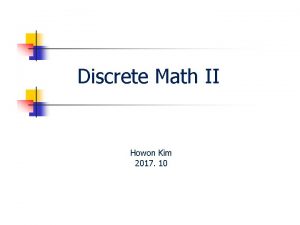Discrete Math II Howon Kim 2019 12 Agenda


























- Slides: 26

Discrete Math II Howon Kim 2019. 12

Agenda n n 11. 1 Definitions 11. 2 Subgraphs, Complements, & Graph Isomorphism n 11. 3 Vertex Degree: Euler Trails & Circuits n 11. 4 Planar Graphs n 11. 5 Hamilton Paths and Cycles n 11. 6 Graph Coloring and Chromatic Polynomials 2

Hamilton Path & Cycle Definition If G=(V, E) is a graph or multigraph with|V| 3, we say that G has a Hamilton cycle if there is a cycle in G that contains every vertex in V. (cycle that passes just once through each vertex of a given graph) A Hamilton path is a path (and not a cycle ) in G that contains each vertex. K 4 Q 3 3

Hamilton Path & Cycle Definition That is, Hamilton cycle: a spanning cycle, that is, a cycle including all the vertices of a graph. Hamiltonian graph: a graph that contains a Hamiltonian cycle. Hamilton path: a path that includes all the vertices of a graph. 4

Example Hamilton Cycle Non-Hamilton Cycle 정 12면체 Dodecahedron 5

Theorem 11. 7 Existence of a Hamilton path in Kn* Let Kn* be a complete directed graph. That is, Kn* has n vertices and for each distinct pair x, y of vertices, exactly one of the edges (x, y) or (y, x) is in Kn*. Such a graph (called a tournament ) always contains a (directed) Hamilton path. K 4* K 5* Tournament is a directed graph obtained by choosing a direction for each edge in an undirected complete graph. The name tournament originates from such a graph's interpretation as the outcome of a round-robin tournament in which every player encounters every other player exactly once. [Wikipedia] 참고: single elimination tournament 6

Proof of Theorem 11. 7 Complete directed graph 에서의 vertex 수: n Let Pm (m 2) a path containing the m-1 edges (v 1, v 2), (v 2, v 3), …, (vm-1, vm). If m=n, we are finished. … … If not, let v be a vertex that doesn’t appear in Pm. If (v, v 1) is an edge in Kn*, we can extend Pm by adjoining this edge. … … Exist 7

Proof of Theorem 11. 7 (v, v 1)아니면 (v 1, v). 둘중 하나. Complete graph 이므로. If not, then (v 1, v) must be an edge. Now suppose that (v, v 2) is in the graph. Then we have the larger path: (v 1, v), (v, v 2), (v 2, v 3), …, (vm-1, vm). … … Ex) 8

Proof of Theorem 11. 7 If (v, v 2) is not an edge in Kn*, then (v 2, v) must be. As we continue this process there are only two possibilities: (a) For some the edges (vk, v), (v, vk+1) are in Kn* and we replace (vk, vk+1) with this pair of edges: or (b) (vm, v) is in Kn* and we add this edge to pm. Either case results in a path pm+1 that includes m+1 vertices and has m edges. … (a) … (b) vm 9

Proof of Theorem 11. 7 This process can be repeated until a Hamilton path is found. 10

Traveling Salesman Problem The problem is: given a number of cities and the costs of travelling from any city to any other city, what is the leastcost round-trip route that visits each city exactly once and then returns to the starting city? It is related to the search for Hamilton cycles in a graph. It is to find a minimum-cost Hamilton cycle in a complete graph whose edges are labeled with costs 11

Traveling Salesman Problem Greedy Algorithm (Nearest-Neighbor Algorithm) Starting at a given vertex, chooses the edge with the least weight to the next possible vertex, that is, to the “closest” vertex. This strategy is continued at each successive vertex until a Hamiltonian cycle is completed. It cannot provide us the optimal solution. K 5 a 7 14 e 5 12 6 13 d b 9 11 8 c 10 Greedy solution (40) ; a d b c e a 7 6 8 5 14 Another solution (37) ; a d b e c a 7 6 9 5 10 12

Traveling Salesman Problem Greedy Algorithm (Nearest-Neighbor Algorithm) 13

Agenda n n 11. 1 Definitions 11. 2 Subgraphs, Complements, & Graph Isomorphism n 11. 3 Vertex Degree: Euler Trails & Circuits n 11. 4 Planar Graphs n 11. 5 Hamilton Paths and Cycles n 11. 6 Graph Coloring and Chromatic Polynomials 14

Graph Coloring Definition If G = (V, E) is an undirected graph, a proper coloring of G occurs when adjacent vertices have different colors. chromatic number The minimum number of colors needed to properly color G, which is written (G) = 3 15

Graph Coloring There is no simple way to actually determine whether an arbitrary graph is ncolorable. However, the following statement gives a simple characterization of 2 colorable graphs. G is 2 -colorable is equivalent to G is bipartite. 16

Coloring Complete Graphs The chromatic number of a complete graph Kn is n. (Kn) = n K 3, 3 ? K 5 (K 5 ) = 5 17

Coloring Planar Graph Any planar graph without loops is 4 colorable. Four Color Conjecture If the regions of any map M are colored so that adjacent regions have different colors, then no more than four colors are required. Posed in 1850 s, proved by K. Appel & W. Haken in 1976 through analyzing 2, 000 different cases. The proof of the above theorem uses computers in an essential way The examination of each different type of graph seems to be beyond the grasp of human beings without the use of a computer. 18

Chromatic Polynomial G be an undirected graph G=(V, E), and let λ be the number of colors that we have available for properly coloring the vertices of G. Let Chromatic polynomial P(G, λ), λ N, of graph G=(V, E) is the function whose value at λ(λ=1, 2, 3…) that is the number of proper colorings f: V {1, 2, 3, …, λ} of G with at most λ colors The chromatic polynomial function P(G, λ), in the variable λ, will tell us in how many different ways we can properly color the vertices of G, using at most λ colors. 19

Chromatic Polynomial If G=(V, E) with |V|=n and E=Ø, then G consists of n isolated points P(G, λ)= λ* λ*…* λ= λn If G=Kn, then at least n colors must be available for us to color G properly. P(G, λ)= λ (λ-1) (λ-2) …(λ-(n-1)) If G is a path on n vertices, then P(G, λ)= λ (λ-1)n-1 20

Chromatic Polynomial If G is a path on n vertices, then P(G, λ)= λ (λ-1)n-1 P(G 1, λ)= λ (λ-1)3 P(G 2, λ)= λ (λ-1)4 λ=1, P(G 1, λ)= P(G 2, λ)=0 λ=2, P(G 1, λ)= P(G 2, λ)=2 That is, (G 1) = (G 2)=2 If five colors are available, then we can properly color G 1 in 5(4)3=320 ways, G 2 in 5(4)4=1280 ways. 21

Chromatic Polynomial If G is made up of components G 1, G 2, …, Gk, then; P(G, λ)=P(G 1, λ) * P(G 2, λ)*…*P(Gk, λ) 22

Chromatic Polynomial Decomposition Thm. For Chromatic Polynomials If G=(V, E) is connected graph and e E, then P(Ge, λ)=P(G, λ) + P(Ge’, λ) 23

Chromatic Polynomial Let G=(V, E) be an undirected graph. For e={a, b} E, let Ge denote the subgraph of G obtained by deleting e from G, without removing vertices a and b; That is, Ge=G-e From Ge a subgraph of G is obtained by coalescing the vertices a and b. It is denoted by G e’ 24

Chromatic Polynomial P(Ge, λ)=P(G, λ) + P(Ge’, λ) P(G, λ) =P(Ge, λ)-P(Ge’, λ) = λ(λ-1)3 - λ(λ-1) (λ-2) = λ(λ-1)(λ 2 -3 λ+3) = λ 4 -4 λ 3+6λ 2 -3 λ Since P(G, 1) =0 while P(G, 2)=2>0, we know that (G)=2 25

Chromatic Polynomial Chromatic numbers for some graphs Graph G (G) Path graph Pn, n≥ 3 2 Cycle graph Cn, n even, n≥ 2 2 Cycle graph Cn, n odd, n≥ 3 3 Complete graph Kn, n even, n≥ 2 n Complete graph Kn, n odd n≥ 3 n Complete bipartite graph Km, n, m, n≥ 1 2 Petersen graph 3 Cycle graph 26
 Howon kim
Howon kim Howon kim
Howon kim Agenda sistemica y agenda institucional
Agenda sistemica y agenda institucional What is discrete mathematics
What is discrete mathematics Inverse error fallacy
Inverse error fallacy Modeling computation discrete math
Modeling computation discrete math Logical equivalence in discrete mathematics
Logical equivalence in discrete mathematics Discrete math problems
Discrete math problems Discrete math propositional logic
Discrete math propositional logic String in discrete mathematics
String in discrete mathematics Irreflexive relation example
Irreflexive relation example Prove set identities
Prove set identities Floor and ceiling discrete math
Floor and ceiling discrete math Four components of mathematical system
Four components of mathematical system A. 1 b. 2 c. 3 d. 4
A. 1 b. 2 c. 3 d. 4 Product rule discrete math
Product rule discrete math What is discrete math
What is discrete math Discrete math cartesian product
Discrete math cartesian product Discrete math susanna epp
Discrete math susanna epp Poset discrete math
Poset discrete math Counterexample discrete math
Counterexample discrete math Recursion discrete math
Recursion discrete math Resolution example
Resolution example Recurrence discrete math
Recurrence discrete math Subtraction rule example
Subtraction rule example Knights and knaves discrete math
Knights and knaves discrete math Structural induction discrete math
Structural induction discrete math
